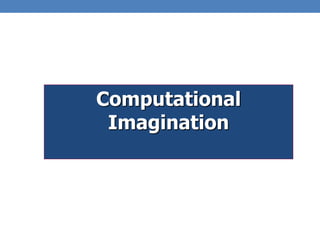
Computational Imagination
- 2. Motivation “Imagination is more important than knowledge ..” Albert Einstein The power of intelligence cannot be entirely identified with logical thinking. “There is no such thing as rational thought ...” “The solution is to make machines more emotional.” Marvin Minsky The Emotion Machine, 2006
- 3. Understanding Imagination Imagination is “the faculty or action of forming ideas or images in the mind.” Oxford English Dictionary • Four different conceptions of imagination as a distinct faculty (Aristotle, Saatre, Kant, Descartes) as memory or a picture in the mind (Hobbes, Acquinas, Furlong, Gibson, Hume) as originality and creativity (Bacon, Kant, Fichte) imageless imagination (Ryle, White, Wittgenstein)
- 4. Modelling Imagination Early computer models agree that imagination uses deep representations stored in LTM Description theory – mental images are structured language-based descriptions Picture theory – mental images are based on ‘functional pictures’, and they fade over time Imagination and emotions (emotional engineering, affective computing, emotional intelligence) Imagination in robotics – perceptual activity theory (need to monitor the environment) The synthesis of perception and imagination is the core process that creates new knowledge. Imagination is essential for innovation and learning.
- 5. Research Goal Computational imagination is the science of modelling human imagination by creating artificial agents with intelligence, emotions and imagination. Goal to study the interplay between cognition, emotion and imagery to analyse the way perceptions, emotions, prior knowledge and context influence imagination to design agents capable of forming concepts and images
- 6. Research Hypothesis Based on existing research in connectionism, pictorialism, descriptionism and perceptual activity theory … and our work on semantics, ontologies, knowledge structures, context-aware systems, social agents, computer vision and AI • Imagination is a process of forming semantically linked mental images, each representing one or more concepts. • Imagination can be formally represented using both visual and linguistic means. • Imagination is influenced by perceptions, emotions, current context and prior knowledge. • The synergy of emotions, imagery and cognition is in the core of imagination.
- 7. Application Scenarios • Imagination gives the ability to look at any situation from a different point of view, and to mentally explore the past and the future. • Inventions, buildings, cars, shopping malls, and any kind of business, started as an idea or concept, and then as a mental image in the mind of their creators. • Imagination can be used to unlock creativity, • Help people/organisations learn from experience by constructing counterfactual (‘if only’ or ‘what if’) scenarios, • Learn new motor skills by supplementing motor training with mental training, • Improve training by visualising flight training maneuvers, • Assist older people by, for instance, helping them remember to comply with medical advice, • Better predict and understand human behavior in unknown or hostile environments, • Prepare for disaster …
- 8. Challenges • Descriptive vs. pictorial • Using both visual and linguistic means • Using image schemata and conceptual metaphors • Natural language constructs and ontologies • Considering prior knowledge (procedural and declarative) stemming from different sources: innate, interactions with the environment and culture. • Considering context: current interactions with the environment, temporal characteristics and social settings
- 9. Challenges • Real-world reasoning • Highly situated and contextualised • Extremely unpredictable and entirely personalised • Alternative ways of reasoning • Associative reasoning • Analogical reasoning • Reasoning under inconsistency (irrational scenarios with contradictions) • Developing ‘common sense’ in robotics
- 10. Conclusions Computational Imagination possesses some of the most challenging and intriguing questions, which once answered, will make imagination reality.
- 11. Computational Imagination • “Imagine” • A summer holiday (abstract scenario) • Your next summer holiday (very personal and contextualised) • The first scene is relatively easy to predict … but the next scenes? There is NO SCRIPT!
- 12. Computational Imagination Imagination is a process of forming semantically linked mental images, each representing one or more concepts. Imagination can be formally represented using both visual and linguistic means. Imagination is influenced by perceptions, emotions, current context and prior knowledge.
- 13. Application Scenarios To mention just a few … Help people learn from experience by constructing counterfactual (‘if only’ or ‘what if’) scenarios, Learn new motor skills by supplementing motor training with mental training, Assist older people by, for instance, helping them remember to comply with medical advice Better predict and understand human behavior in unknown or hostile environments, Prepare for disaster …